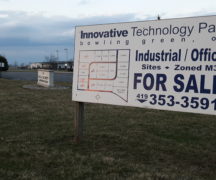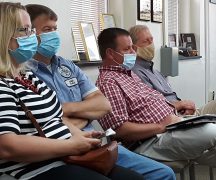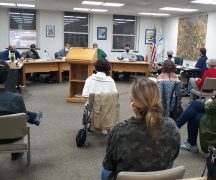By JAN LARSON McLAUGHLIN
BG Independent News
Last week’s pipeline panel discussion raised questions that Bowling Green officials want answered.
“We’ve all been wrestling with this,” Mayor Dick Edwards said Monday evening as he sought council input on the letter he penned. The letter received support from council, including an endorsement from member Daniel Gordon, who called it “strongly and appropriately worded.”
The letters will be sent to the Federal Energy Regulatory Commission, U.S. Senators Sherrod Brown and Rob Portman, U.S. Rep. Bob Latta and Nexus pipeline. Slightly modified letters will also be sent to State Senator Randy Gardner, State Rep. Theresa Gavarone, Ohio EPA, Ohio Department of Natural Resources and possibly PUCO.
Gordon said the lack of deadlines for the pipeline makes it difficult for those objecting to the project.
“It’s a source of a great deal of frustration,” Edwards said. The decision rests with the federal government. “It’s frustrating for municipalities to take on the federal government.”
The mayor stressed the need to send the letter as soon as possible. “We are trying to establish a record of concern,” he said. “We will try our best to keep pressing the issues.”
Edwards also expressed concerns about the pipeline company, which refuses to answer questions about the project. “I’m disappointed with the Nexus group.”
Gordon suggested the city add a timetable to the letter, and warn that the city will take the next step if questions are answered adequately. Even if there is a low probability of getting the pipeline rerouted, “it’s worth taking that chance.”
Because of possible threats to the city’s water treatment plant, the city has a responsibility “on a moral and policy basis to stand up against this,” Gordon said.
But other council members questioned what that “next step” might be. Unlike other cities challenging the Nexus pipeline, Bowling Green does not have the funds to battle the company in court.
Council member John Zanfardino suggested the possibility of filing a motion to intervene, which may not be costly.
“I want to feel good morally, challenging them the best we can,” Zanfardino said. He expressed concern that the FERC approval process is “a lot of rubber stamping.”
Following is a copy of the draft letter to be sent out from Bowling Green officials:
Thank you for facilitating communications with the Federal Energy Regulatory Agency (FERC) and other entities involved with the important issue of the proposed NEXUS pipeline and its proximity to the Bowling Green Water Treatment Plant on the Maumee River.
We are writing to you once again because of a heightened sense of concern and urgency about the issue as a result of additional study and investigation. We are not questioning or debating the issue of the pipeline per se but only the physical alignment of the project and the potential threat it poses for the service and quality of water which not only serves the citizens of Bowling Green but the City of Waterville and numerous other political entities in Wood County using BG water including the Northwest Water and Sewer District.
Over the years, the City of Bowling Green has invested millions and millions of local, state and federal dollars into the Water Treatment Plant which is carefully regulated by the Ohio Environmental Protection Agency. As a result, it is a state-of-the-art facility, clearly one of the best operations of its kind in this region and perhaps is among some of the best in the State of Ohio. As a city government in concert with an independent Board of Public Utilities, we have made a substantial commitment to the reverse osmosis process with even more improvements to follow.
Our concern is focused on one overwhelmingly important and seemingly overlooked aspect of the project’s picture by both NEXUS and FERC as follows: Based on the evaluation of the pipeline project by independent analysts and information already provided to FERC, we have every reason to believe that the proposed location within close proximity to the Water Treatment Plant, its support reservoir and the carefully researched geologic structure of the Bowling Green Fault Zone, poses a potentially extraordinary risk to the future of Bowling Green water and to the immediate environment.
This conclusion was reached after months of independent fact finding, two independently commissioned research studies, and the findings of an independent panel of experts who participated in a public forum organized by the Bowling Green Mayor for the benefit of City Council and the citizens of Bowling Green on May 8, 2017.
Panelists were: Dr. Charles Onasch, Professor Emeritus of Geology at Bowling Green State University (BGSU), who is widely acknowledged and respected for his research on the Bowling Green Fault; Dr. Andrew Kear, Assistant Professor of Political Science and Environment and Sustainability at BGSU with degrees in geology; Mark Baranoski, retired Geologist with the Ohio Geological Survey and whose research is significantly referenced in analyses of the pipeline project; and Stephen Champa, a Senior Hydrogeologist for Eagon & Associates of Worthington, OH.
Each of the foregoing efforts to independently seek and identify pertinent factual information aligned with the project and its location to the Water Treatment Plant, including a FERC reported study by the internationally respected Fluor Enterprises of Houston, TX, have concluded the following:
- That significant geophysical data is either missing from or not reported by NEXUS and acknowledged by FERC related to the potential threats posed by the BG Fault (despite no evidence of seismic activity for thousands of years) and the geologic structure, i.e., subsurface conditions, of that area where the proposed pipeline will go under the Maumee River;
- That from an engineering perspective and the planned use of the technique known as Horizontal-Directional Drilling (HDD), there is considerable concern about the “unknowns” below the surface and a bedrock that is characterized by extreme fracturing which may increase the risk of HDD operational problems; and
- That the site location for the HDD process given its proximity to the Water Treatment Plant and the Fault raises serious questions about the risk/safety factor of proceeding at the planned location which has been described by one analyst as the “worst possible” site, especially in light of several possible alternative routes “upstream” that would not pose an immediate threat to the Water Treatment Plant.
- That given some of the drilling problems associated with other pipeline projects in the State, there has been no “spelling out” how the work will be monitored to ensure low risk-maximum safety considerations and the role of both FERC and the Ohio Environmental Protection Agency in this regard.
Therefore, we respectfully request and sincerely hope that additional steps will be undertaken in the final stages of the FERC review process to analyze the situation more deeply, answer some of the unanswered questions and address the gaps in data, and at the very least explore more thoroughly an alternate route, one that is at least more than a mile upstream from the Water Treatment Plant. Almost daily we are reminded of the painful and costly pipeline and drilling related malfunctions and serious threats to the environment in other sections of Ohio, and while clearly the geology of NW Ohio is significantly different from SE Ohio, we nevertheless don’t want to heighten the risk factor by a crossing of the pipeline adjacent to the BG Water Treatment Plant.
Thank you for your consideration of the foregoing points and any assist you can lend to impress upon both FERC and NEXUS our deeply rooted and well-studied concerns from a Bowling Green perspective.
Sincerely,
Richard A. Edwards, Mayor
Michael Aspacher, President of City Council





